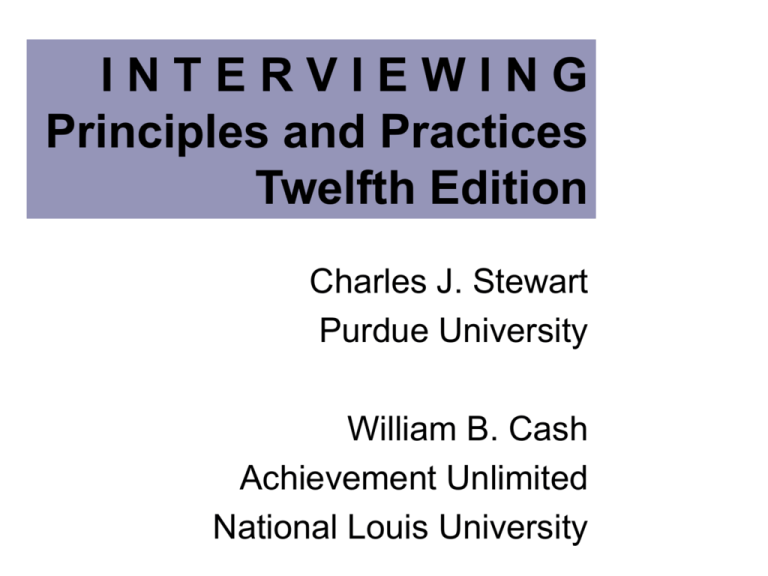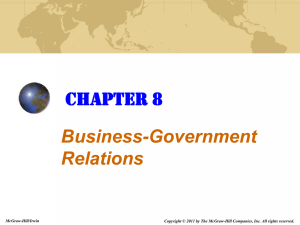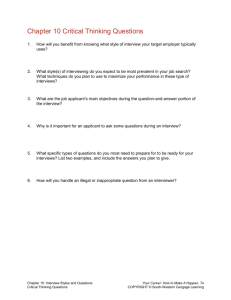
INTERVIEWING
Principles and Practices
Twelfth Edition
Charles J. Stewart
Purdue University
William B. Cash
Achievement Unlimited
National Louis University
Slide 2
An Introduction to
Interviewing
CHAPTER
1
Chapter Summary
•An Introduction to Interviewing
•The Essential Elements of Interviews
•A Relational Form of Communication
•Electronic Interviews
•Summary
© 2009 The McGraw-Hill Companies, Inc. All rights reserved.
Slide 3
Introduction
• Interviews share characteristics with intimate
interactions, social conversations, small groups,
and presentations, but are significantly different.
© 2009 The McGraw-Hill Companies, Inc. All rights reserved.
Slide 4
Introduction
• Interviews share characteristics with intimate
interactions, social conversations, small groups,
and presentations, but are significantly different.
• Interviews are distinguishable from other forms
of interpersonal communication, and can be
viewed as a relational form of communication.
© 2009 The McGraw-Hill Companies, Inc. All rights reserved.
Slide 5
The Essential Elements of
Interviews
The Five Elements of Interviews
Interactional
An interview is interactional because there is an
exchanging, or sharing, of roles, responsibilities,
feelings, beliefs, motives, and information.
Continued…
© 2009 The McGraw-Hill Companies, Inc. All rights reserved.
Slide 6
The Essential Elements of
Interviews
Interactional
•Roles may switch from moment to moment.
•It takes two to make an interview a success.
© 2009 The McGraw-Hill Companies, Inc. All rights reserved.
Slide 7
The Essential Elements of
Interviews
Interactional
•Roles may switch from moment to moment.
•It takes two to make an interview a success.
•Disclosure is essential in interviews.
•All interviews involve risk.
© 2009 The McGraw-Hill Companies, Inc. All rights reserved.
Slide 8
The Essential Elements of
Interviews
Process
•An interview is a complex, ever-changing process.
•No interview occurs in a vacuum.
•Once initiated, the interview is an ongoing
process.
© 2009 The McGraw-Hill Companies, Inc. All rights reserved.
Slide 9
The Essential Elements of
Interviews
Parties
• A dyadic process involves two parties.
• If more than two parties are involved, a small
group interaction may be occurring, but not an
interview.
© 2009 The McGraw-Hill Companies, Inc. All rights reserved.
Slide 10
The Essential Elements of
Interviews
Purpose
• All interviews have a degree of structure.
• An interview is a conversation and much more.
© 2009 The McGraw-Hill Companies, Inc. All rights reserved.
Slide 11
The Essential Elements of
Interviews
Questions
• All interviews involve questions and answers.
• Questions play multiple roles in interviews.
© 2009 The McGraw-Hill Companies, Inc. All rights reserved.
Slide 12
A Relational Form of
Communication
• The concept of relationship is inherent in the
definition of “interviewing”
• Each interview contributes to a relational history
• Interviews with no prior history may be difficult
“precisely because we don’t know the rules and so
we don’t know exactly how to coordinate our
conversational moves.”
© 2009 The McGraw-Hill Companies, Inc. All rights reserved.
Slide 13
A Relational Form of
Communication
• Stereotypes often play significant negative roles
in interactions between strangers, since the parties
have exchanged little personal information.
• Relationships change over time and during
interactions.
•The situation may alter a relationship.
© 2009 The McGraw-Hill Companies, Inc. All rights reserved.
Slide 14
A Relational Form of
Communication
Relational Dimensions
The five dimensions that determine the nature of
our relationships in the interview process:
© 2009 The McGraw-Hill Companies, Inc. All rights reserved.
Slide 15
A Relational Form of
Communication
Relational Dimensions
The five dimensions that determine the nature of
our relationships in the interview process:
1. Similarity
© 2009 The McGraw-Hill Companies, Inc. All rights reserved.
Slide 16
A Relational Form of
Communication
Relational Dimensions
The five dimensions that determine the nature of
our relationships in the interview process:
1. Similarity
2. Inclusion/Involvement
© 2009 The McGraw-Hill Companies, Inc. All rights reserved.
Slide 17
A Relational Form of
Communication
Relational Dimensions
The five dimensions that determine the nature of
our relationships in the interview process:
1. Similarity
2. Inclusion/Involvement
3. Affection
© 2009 The McGraw-Hill Companies, Inc. All rights reserved.
Slide 18
A Relational Form of
Communication
Relational Dimensions
The five dimensions that determine the nature of
our relationships in the interview process:
1. Similarity
2. Inclusion/Involvement
3. Affection
4. Control
© 2009 The McGraw-Hill Companies, Inc. All rights reserved.
Slide 19
A Relational Form of
Communication
Relational Dimensions
The five dimensions that determine the nature of
our relationships in the interview process:
1. Similarity
2. Inclusion/Involvement
3. Affection
4. Control
5. Trust
© 2009 The McGraw-Hill Companies, Inc. All rights reserved.
Slide 20
A Relational Form of
Communication
Global Relationships
•
Our social and work worlds have become
global.
•
We must understand cultures to live and work
in the 21st Century.
© 2009 The McGraw-Hill Companies, Inc. All rights reserved.
Slide 21
A Relational Form of
Communication
Men and Women in Relationships
•
Men and women communicate differently.
•
Women use communication as a primary way
of establishing relationships.
•
Men communicate “to exert control, preserve
independence, and enhance status.”
© 2009 The McGraw-Hill Companies, Inc. All rights reserved.
Slide 22
Electronic Interviews
The Telephone
• The telephone interview is convenient and
inexpensive.
• Interviewers and interviewees can talk to several
people at one time, answer or clarify questions
directly, and receive immediate feedback.
• A major drawback with telephone interviews is
the lack of “presence” of parties.
© 2009 The McGraw-Hill Companies, Inc. All rights reserved.
Electronic Interviews
The Cellular Telephone
Cellular Telephones Have Created a Whole
New World of Talking
Their Usage Has Created a New Concern for
Privacy
© 2009 The McGraw-Hill Companies, Inc. All rights reserved.
Electronic Interviews
Videoconferencing
Eight of Ten Companies Use Them for Recruiting
Interviews
Visual Cues Are Limited to Upper-Body Ones
Videoconference Interviews Provide Less
Nonverbal Information
Interviewees Do Not Prefer Videoconference
Interviews
© 2009 The McGraw-Hill Companies, Inc. All rights reserved.
Slide 25
Electronic Interviews
The Internet
• The internet lacks the nonverbal cues critical in
interviews.
• However, if both parties use the internet to
interact in real time, it meets the definition of an
interview.
© 2009 The McGraw-Hill Companies, Inc. All rights reserved.
Slide 26
Summary
•Interviewing is an interactional communication
between two parties, at least one of whom has a
predetermined and serious purpose, that involves
the asking and answering of questions.
•We employ interviews to get and give
information, to recruit, to assess performance, to
persuade, to counsel, and receive help, and to
provide quality healthcare.
© 2009 The McGraw-Hill Companies, Inc. All rights reserved.
Chapter 2
An Interpersonal
Communication Process
Chapter Summary
Two Parties in the Interview
Interchanging Roles During Interviews
Perceptions of Interviewer and Interviewee
Communication Interactions
Feedback
The Interview Situation
Outside Forces
Summary
© 2009 The McGraw-Hill Companies, Inc. All rights reserved.
Two Parties in the Interview
The Two Parties in the Interview
Each party consists of unique and complex
individuals.
Although each party consists of unique
individuals, both must act together if the interview
is to be successful.
© 2009 The McGraw-Hill Companies, Inc. All rights reserved.
Two Parties in the Interview
© 2009 The McGraw-Hill Companies, Inc. All rights reserved.
Interchanging Roles During
Interviews
Slide 31
Both parties speak and listen from time to
time, are likely to ask and answer questions,
and take on the roles of interviewer and
interviewee.
Two fundamental approaches to interviewing:
directive or nondirective.
© 2009 The McGraw-Hill Companies, Inc. All rights reserved.
Interchanging Roles During
Interviews
© 2009 The McGraw-Hill Companies, Inc. All rights reserved.
Interchanging Roles During
Interviews
Directive Approach
A directive approach allows the interviewer to
maintain control.
Nondirective Approach
A nondirective approach enables the interviewee
to share control.
© 2009 The McGraw-Hill Companies, Inc. All rights reserved.
Interchanging Roles During
Interviews
Combination of Approaches
Be flexible and adaptable when selecting
approaches.
The roles we play should guide but not dictate
approaches.
© 2009 The McGraw-Hill Companies, Inc. All rights reserved.
Perceptions of Interviewer and
Interviewee
Four Perceptions Drive Interactions
1.
2.
3.
4.
Self-perceptions
Perceptions of the other party
How the other party perceives us
How the other party perceives self
© 2009 The McGraw-Hill Companies, Inc. All rights reserved.
Perceptions of Interviewer and
Interviewee
© 2009 The McGraw-Hill Companies, Inc. All rights reserved.
Perceptions of Interviewer and
Interviewee
Perceptions of Self
What we perceive ourselves to be may be more
important than what we are.
We see ourselves differently under different
circumstances.
Self-esteem is closely related to self-worth.
© 2009 The McGraw-Hill Companies, Inc. All rights reserved.
Perceptions of Interviewer and
Interviewee
Perceptions of the Other Party
Perceptions are a two-way process.
Allow interactions to alter or reinforce perceptions.
© 2009 The McGraw-Hill Companies, Inc. All rights reserved.
Communication Interactions
Levels of Interactions
Level 1 Interactions:
Avoid judgments, attitudes, and feelings
Are safe and superficial
Dominate interactions where there is little relational
history, where trust has yet to be established, and the
role relationship between superiors and subordinates.
© 2009 The McGraw-Hill Companies, Inc. All rights reserved.
Communication Interactions
Levels of Interactions
Level 2 Interactions:
Require trust and risk-taking
More revealing of ideas, feelings, and information
Although riskier, can be ended easily
© 2009 The McGraw-Hill Companies, Inc. All rights reserved.
Communication Interactions
Levels of Interactions
Level 3 Interactions:
Involve full disclosure
Deal with intimate and controversial areas of inquiry
Requires a positive relationship
© 2009 The McGraw-Hill Companies, Inc. All rights reserved.
Communication Interactions
© 2009 The McGraw-Hill Companies, Inc. All rights reserved.
Communication Interactions
Sex, Culture, and Interactions
Women disclose more freely than men.
Culture may dictate what we disclose and to
whom.
Positive and negative face are universal motives.
© 2009 The McGraw-Hill Companies, Inc. All rights reserved.
Communication Interactions
Verbal Interactions
Never assume communication is taking place.
A word rarely has a single meaning.
Words may be so ambiguous that any two parties
may assign very different meanings to them.
Beware of words that sound alike.
Words are rarely neutral.
© 2009 The McGraw-Hill Companies, Inc. All rights reserved.
Communication Interactions
Nonverbal Interactions
Nonverbal signals send many different messages.
Any behavioral act, or its absence, can convey a
message.
In mixed messages, the how may overcome the
what.
Verbal and nonverbal messages are intricately
intertwined.
© 2009 The McGraw-Hill Companies, Inc. All rights reserved.
Feedback
Be perceptive, sensitive, and receptive.
It is difficult to listen with your mouth open
and your ears closed.
Be flexible in selecting listening approaches.
© 2009 The McGraw-Hill Companies, Inc. All rights reserved.
Feedback
© 2009 The McGraw-Hill Companies, Inc. All rights reserved.
Feedback
Listening for Comprehension
Listening for Empathy
The intent of empathic listening is to understand the other
party.
Listening for Evaluation
The intent of listening for comprehension is to understand
content.
The intent of evaluative listening is to judge content and
actions.
Listening for Resolution
The intent of dialogic listening is to resolve problems.
© 2009 The McGraw-Hill Companies, Inc. All rights reserved.
The Interview Situation
© 2009 The McGraw-Hill Companies, Inc. All rights reserved.
The Interview Situation
Initiating the Interview
• Who initiates an interview and how may affect
control, roles, and atmosphere.
© 2009 The McGraw-Hill Companies, Inc. All rights reserved.
The Interview Situation
Perceptions
A party may see the interview as routine or an
event.
Settings are seldom neutral.
Perceptions are critical in moving beyond Level 1
interactions.
© 2009 The McGraw-Hill Companies, Inc. All rights reserved.
The Interview Situation
Time of Date, Week, and Year
Each of us has an optimum time for interactions.
Take into account events before and after
interviews.
© 2009 The McGraw-Hill Companies, Inc. All rights reserved.
The Interview Situation
Place
We value and protect our turf.
Don’t underestimate the importance of place.
© 2009 The McGraw-Hill Companies, Inc. All rights reserved.
The Interview Situation
Surroundings
Surroundings help to create a productive climate.
Control noise to focus attention on the interaction.
Come to each interview ready to communicate.
© 2009 The McGraw-Hill Companies, Inc. All rights reserved.
The Interview Situation
Territoriality
Maintain an arm’s length of distance between
parties.
Relationship affects territorial comfort zones.
Age, sex, and culture influence territorial
preferences.
Continued…
© 2009 The McGraw-Hill Companies, Inc. All rights reserved.
The Interview Situation
Territoriality
Seating Arrangement
Desire for control often determines seating.
Seating may equalize control and enhance the
interview climate.
© 2009 The McGraw-Hill Companies, Inc. All rights reserved.
The Interview Situation
© 2009 The McGraw-Hill Companies, Inc. All rights reserved.
Outside Forces
We are not really alone with the other party.
Outside forces determine roles in many
interviews.
Know what advice you must take.
© 2009 The McGraw-Hill Companies, Inc. All rights reserved.
Outside Forces
© 2009 The McGraw-Hill Companies, Inc. All rights reserved.
Summary
Interviewing is a dynamic, complicated
process between two complex parties
operating with imperfect verbal and nonverbal
symbols guided and controlled by
perceptions and the situation.
A thorough understanding of the process is a
prerequisite for successful interviewing.
Interviewer and interviewee must be flexible
and adaptable in choosing which approach to
take.
© 2009 The McGraw-Hill Companies, Inc. All rights reserved.
Chapter 3
Questions and Their Uses
Chapter Summary
Open and Closed Questions
Primary and Secondary Questions
Neutral and Leading Questions
Common Question Pitfalls
Summary
© 2009 The McGraw-Hill Companies, Inc. All rights reserved.
Open and Closed Questions
Open Questions
• Open questions are broad, often specifying only
a topic, and allow the respondent considerable
freedom in determining the amount and kind of
information to offer.
© 2009 The McGraw-Hill Companies, Inc. All rights reserved.
Open and Closed Questions
Open Questions
• Highly Open Questions
• Moderately Open Questions
• Open Questions Have Advantages
• Open Questions Have Disadvantages
© 2009 The McGraw-Hill Companies, Inc. All rights reserved.
Open and Closed Questions
Closed Questions
• Closed questions are narrow in focus and
restrict the interviewee’s freedom to determine the
amount and kind of information to offer.
© 2009 The McGraw-Hill Companies, Inc. All rights reserved.
Open and Closed Questions
Closed Questions
• Moderately Closed Questions
• Highly Closed Questions
• Bipolar Questions
• Closed Questions Have Advantages
• Closed Questions Have Disadvantages
© 2009 The McGraw-Hill Companies, Inc. All rights reserved.
Primary and Secondary
Questions
Primary questions introduce topics or new
areas within a topic and can stand alone
even when taken out of context.
Secondary questions attempt to discover
additional information following a primary or
secondary question. They are often called
probing or follow-up questions.
© 2009 The McGraw-Hill Companies, Inc. All rights reserved.
Primary and Secondary
Questions
Types of Secondary Questions
Silent Probes
Nudging Probes
Clearinghouse Probes
Informational Probes
Restatement Probes
Reflective Probes
Mirror Probes
© 2009 The McGraw-Hill Companies, Inc. All rights reserved.
Primary and Secondary
Questions
Skillful Interviewing with Probing Questions
Skillful probing leads to insightful answers.
Be patient and be persistent.
© 2009 The McGraw-Hill Companies, Inc. All rights reserved.
Primary and Secondary
Questions
© 2009 The McGraw-Hill Companies, Inc. All rights reserved.
Neutral and Leading Questions
Neutral questions encourage honest
answers.
Leading questions direct interviewees to
specific answers.
Interviewer bias leads to dictated
responses.
Loaded questions dictate answers through
language or entrapment.
© 2009 The McGraw-Hill Companies, Inc. All rights reserved.
Neutral and Leading Questions
© 2009 The McGraw-Hill Companies, Inc. All rights reserved.
Common Question Pitfalls
The Bipolar Trap
The Open-to-Closed Switch
The Double-Barreled Inquisition
The Leading Push
The Guessing Game
The Yes (No) Response
The Curious Probe
Complexity Vs. Simplicity
The Quiz Show
The Don’t Ask, Don’t Tell
© 2009 The McGraw-Hill Companies, Inc. All rights reserved.
Summary
Questions are the tools of the trade for both
interviewers and interviewees.
Knowing question types, unique uses, and
advantages and disadvantages, allows one to
develop considerable interviewing skill.
© 2009 The McGraw-Hill Companies, Inc. All rights reserved.






